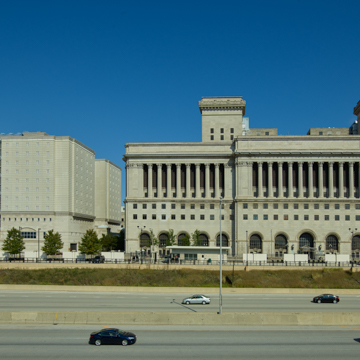From almost any vantage point, the Milwaukee County Courthouse exerts a powerful effect. In its scale, massing, and cold formality, the building represents the last grand monument of the Beaux-Arts classical movement in Wisconsin. Progressive Era planners first conceived Milwaukee’s civic center in the early twentieth century. In classic City Beautiful fashion, they mapped out an expansive public green around which city and county government buildings would be arranged. The planners called for a grand county court-house atop a low hill, overlooking the green and serving as its architectural focal point. Construction was delayed for over a decade by political squabbling and by public reluctance to foot the sizable bill. But in the late 1920s once financing became available, Ross won a nationwide competition to design the new courthouse.
The monumental edifice rests on a four-story base consisting of an arcade of two-story-tall round-arched openings, surmounted by two stories of small, square windows set in fields of rusticated limestone block. Atop this, a spectacular colonnade of four-story-tall Corinthian columns wraps around all sides with a central pavilion that projects slightly and above the flanking wings. Crowning the colonnade are a full classical entablature and a tall parapet wall. The public spaces inside the courthouse are equally striking. The grand corridor on the first story is finished with a barrel-vaulted plaster ceiling and travertine marble wainscoting and floors. Most original hanging lights remain.


